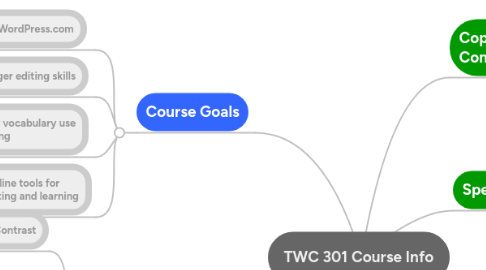
1. Course Goals
1.1. Become fluent using WordPress.com
1.2. Develop stronger editing skills
1.3. Broaden my vocabulary use within writing
1.4. Discover online tools for writing, editing and learning
2. C.R.A.P. Design Principles
2.1. Contrast
2.1.1. The idea behind contrast is to avoid elements on the page that are merely similar. If the elements (type, color, size, line thickness, shape, space, etc.) are not the same, then make them very different. Contrast is often the most important visual attraction on a page.
2.2. Repetition
2.2.1. Repeat visual elements of the design throughout the piece. You can repeat color, shape, texture, spatial relationships, line thicknesses, sizes, etc. This helps develop the organization and strengthens the unity.
2.3. Alignment
2.3.1. Nothing should be placed on the page arbitrarily. Every element should have some visual connection with another element on the page. This creates a clean, sophisticated, fresh took.
2.4. Proximity
2.4.1. Items relating to each other should be grouped close together. When several items are in close proximity to each other, they become one visual unit rather than several separate units. This helps organize information and reduces clutter.
3. Outcomes
3.1. Rhetorical Knowledge
3.1.1. Identify, articulate, and focus on a defined purpose
3.1.2. Respond to the need of the appropriate audience
3.1.3. Respond appropriately to different rhetorical situations
3.1.4. Use conventions of format and structure appropriate to the rhetorical situation
3.1.5. Adopt appropriate voice, tone, and level of formality
3.1.6. Understand how each genre helps to shape writing and how readers respond to it
3.1.7. Write in multiple genres
3.1.8. Understand the role of a variety of technologies/media in accessing, retrieving, managing, and communicating information
3.1.9. Use appropriate technologies to organize, present, and communicate information to address a range of audiences, purposes, and genres
3.2. Critical Thinking, Reading and Writing
3.2.1. Use information, writing, and reading for inquiry, learning, thinking, and communicating
3.2.2. Integrate previously held beliefs, assumptions, and knowledge with new information and the ideas of others to accomplish a specific purpose within a context
3.3. Processes
3.3.1. Be aware that it usually takes multiple drafts to create and complete a successful text
3.3.2. Develop flexible strategies for generating, revising, editing, and proof-reading
3.3.3. Understand the collaborative and social aspects of research and writing processes
3.3.4. Use appropriate technologies to manage data and information collected or generated for future use
3.4. Knowledge of Conventions
3.4.1. Learn common formats for different genres
3.4.2. Develop knowledge of genre conventions ranging from structure and paragraphing to tone and mechanics
3.4.3. Understand and apply legal and ethical uses of information and technology including copyright and intellectual property
